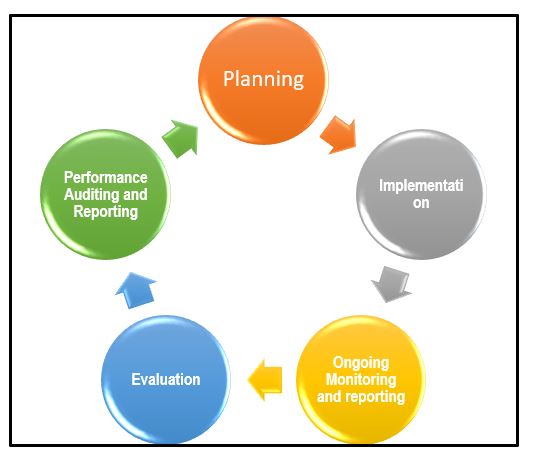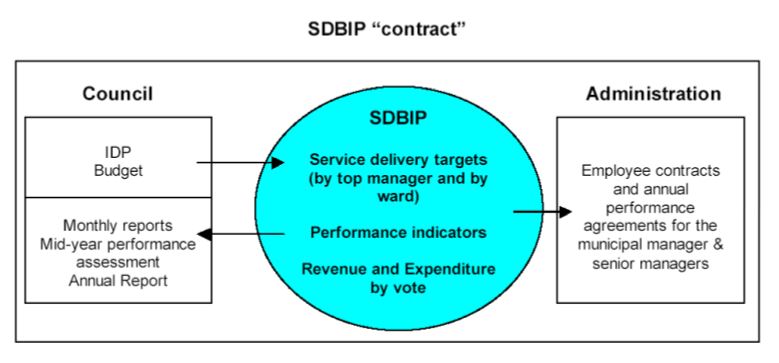ORGANISATIONAL PERFORMANCE MANAGEMENT SYSTEM
The Ugu District Municipality adopts a reviewed Performance Management Policy and Procedural Framework annually for the purpose of ensuring proper planning, implementation, monitoring and evaluation of performance management within the municipality. The policy also outlines the structural processes of accountability. The policy aims at ensuring improvement in the Organisational and Individual Performance Management system of Ugu District Municipality, which eventually would contribute to improving effectiveness and efficiency of the municipality in terms of delivering services to the community.
The municipality has merged OPMS and SDBIP processes to ensure consistent alignment in the implementation. This is in line with the legislation as the Municipal Systems Act (MSA), 2000 requires municipalities to establish a performance management system. Further, the MSA and the Municipal Finance Management Act (MFMA) requires the Integrated Development Plan (IDP) to be aligned to the municipal budget and to be monitored for the performance of the budget against the IDP via the Service Delivery and the Budget Implementation Plan (SDBIP).
Performance Management Cycle
The Standard Operating and Procedure (SOP) Manual encompasses planning, implementation, monitoring and evaluation and incorporates the alignment of an organizational performance management system with an individual performance system is illustrated in the diagram below.

Service Delivery and Budget Implementation Plan
The SDBIP facilitates the process of holding management accountable for their performance. It provides the basis for measuring performance in the delivery of services.
Legislative Mandates
The SDBIP is essentially the management and implementation tool which sets in-year information, such as quarterly service delivery targets, and links each service delivery output to the budget of the municipality, thus providing credible management information and a detailed plan for how the municipality will provide such services and the inputs and financial resources to be used (MFMA Circular 13).
The SDBIP therefore serves as a "contract" between the administration, Council and community expressing the goals and objectives set by the Council as quantifiable outcomes that can be implemented by the administration over the next twelve months. This provides the basis for measuring performance in service delivery against end of year targets and implementing the budget.

Figure 7.2.1: IDP SDBIP Link Source: MFMA Circular No. 13, 2005
Geographic Information System (GIS) is a system of computer software, hardware and data, and personnel to help manipulate, analyze and present information that is tied to a spatial location.
It is made up of five key components which includes
- Hardware – Computers, PCs, Laptops, Printers etc
- Software – GIS software and applications etc
- Data – Attribute, vector, raster etc
- Methods – Guidelines, specifications, norms and standards and procedures
- People – Administrators, Managers, GIS Practitioners, end users
The Geographic Information System unit is in the office of the Municipal Manager (OMM) and is hereby entrusted with ownership of all GIS related activities. The unit lends itself towards assisting all departments with any and every GIS related request.
An excellent GIS service relies on excellent GIS data, and the only way to ensure this is to implement rigorous GIS data maintenance procedures. This requires human capacity, funding, established and enforced maintenance processes, and a consistency in all these areas. Certain partner organisations such as Statistics South Africa, Department of Rural Development and Land Reform, Provincial Government Departments in Kwa-Zulu Natal, and KZN COGTA will continue to be the custodians of their data and will continue to maintain and supply this data on an ongoing basis to Ugu District Municipality.
The Ugu GIS unit also has a critical role to play in recording and monitoring the assets of the District. Two major categories are a) the properties that Ugu and its municipalities own, and b) infrastructure. For Ugu, water and sanitation infrastructure are by far the most valuable category of asset that has taken an enormous effort to capture into GIS. There is still some work to go on the water network GIS layers for the entire District. The Ugu GIS unit also must provide information support to other components with Ugu DM, especially Water services, Local Economic Development, Disaster Management, Strategic Planning and Spatial Planning. The data needs of these components and their priorities have been documented previously.
Ugu District Municipality's Spatial Development Framework (SDF) is intended, in part, to comply with Section 26(e) of the Municipal Systems Act, Act No. 32 of 2000) as well as Chapter 4, Part E of the Spatial Planning and Land Use Management Act (Act No.16 of 2013), which requires all municipalities to prepare and adopt an SDF as a component of its Integrated Development Plan (IDP).
Purpose of a Municipal spatial Development Framework
- Guide planning and development decisions across all sectors of government and specifically the municipality and provincial government in its spatial planning and land use management decisions;
- Provide direction for strategic developments, infrastructure investment, promote efficient, sustainable and planned investments by all sectors and indicate priority areas for investment in land development;
- Take cognisance of any environmental management instrument adopted by the relevant environmental management authority;
- Assist in integrating, coordinating, aligning and expressing development policies and plans emanating from the various sectors of the spheres of government as they apply within the municipal area;
- Prioritising, mobilising, sequencing and implementing of public and private infrastructure;
- Aligns spatial development goals, strategies and policies with relevant national and provincial spatial principles, strategies and policies;
- Spatially coordinates, prioritises and aligns public investment in the IDP;
- Directs and supports private and public investment by identifying areas that are suitable for urban development;
- Provides policy guidance to direct decision-making on the nature, form, scale and location of urban development,
- Ensure developmental oriented planning
An important component of the SDF is the Capital Investment Framework (CIF), wherein the district must ensure that whatever is included in the district CIF is aligned and reflects what is happening at local level. Solutions in the problem lie in the district coordinating alignment sessions where all stakeholders present their medium- and long-term projects.
 In compliance with the Local Government Municipal Systems Act, 32 of 2000, the Ugu District Council adopts a five-year Integrated Development Plan and reviews it for annually for the duration of a term of Council. This plan is meant to provide a basis for both public and private sector investment in the district and is reviewed on an annual basis.
In compliance with the Local Government Municipal Systems Act, 32 of 2000, the Ugu District Council adopts a five-year Integrated Development Plan and reviews it for annually for the duration of a term of Council. This plan is meant to provide a basis for both public and private sector investment in the district and is reviewed on an annual basis.
The Ugu District Municipality IDP is prepared in terms of the legislative requirements as entailed in chapter five (5) of the Municipal Systems Act. Consideration is given to the MEC's comments that are raised following the annual submission. An in-house team led by the Office of the Municipal Manager is assigned the task of developing and reviewing the IDP. To ensure ownership of the process and to gather community inputs, existing municipal structures and systems i.e., IDP Representative Forum, IDP and Budget Road Shows are also used.
If operational excellence is achieved the result will be good governance and administration, sound financial management and viability, innovative, effective, and efficient institution, and administration. In general, Ugu District Municipality through stakeholder relations is striving for:
- Coordinated, effective and efficient planning and service delivery.
- A credible and well informed IDP
- Better investments and reduced dependency on grants.
- Protest free and happy communities.
- Confident investors and partners in service delivery.
- Social cohesion.
- Quality input and engagements.
- Vibrant and active tourism, increasing investment and job opportunities.
- Realisation of a developmental state